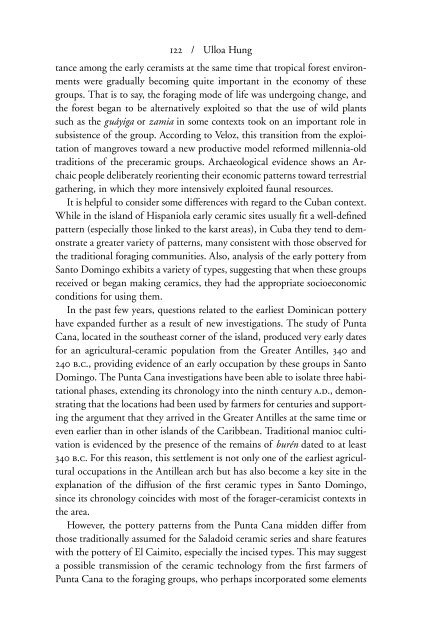Dialogues in Cuban Archaeology
by L. Antonio Curet, Shannon Lee Dawdy, and Gabino La Rosa Corzo
by L. Antonio Curet, Shannon Lee Dawdy, and Gabino La Rosa Corzo
Create successful ePaper yourself
Turn your PDF publications into a flip-book with our unique Google optimized e-Paper software.
122 / Ulloa Hung<br />
tance among the early ceramists at the same time that tropical forest environments<br />
were gradually becom<strong>in</strong>g quite important <strong>in</strong> the economy of these<br />
groups. That is to say, the forag<strong>in</strong>g mode of life was undergo<strong>in</strong>g change, and<br />
the forest began to be alternatively exploited so that the use of wild plants<br />
such as the guáyiga or zamia <strong>in</strong> some contexts took on an important role <strong>in</strong><br />
subsistence of the group. Accord<strong>in</strong>g to Veloz, this transition from the exploitation<br />
of mangroves toward a new productive model reformed millennia-old<br />
traditions of the preceramic groups. Archaeological evidence shows an Archaic<br />
people deliberately reorient<strong>in</strong>g their economic patterns toward terrestrial<br />
gather<strong>in</strong>g, <strong>in</strong> which they more <strong>in</strong>tensively exploited faunal resources.<br />
It is helpful to consider some differences with regard to the <strong>Cuban</strong> context.<br />
While <strong>in</strong> the island of Hispaniola early ceramic sites usually ¤t a well-de¤ned<br />
pattern (especially those l<strong>in</strong>ked to the karst areas), <strong>in</strong> Cuba they tend to demonstrate<br />
a greater variety of patterns, many consistent with those observed for<br />
the traditional forag<strong>in</strong>g communities. Also, analysis of the early pottery from<br />
Santo Dom<strong>in</strong>go exhibits a variety of types, suggest<strong>in</strong>g that when these groups<br />
received or began mak<strong>in</strong>g ceramics, they had the appropriate socioeconomic<br />
conditions for us<strong>in</strong>g them.<br />
In the past few years, questions related to the earliest Dom<strong>in</strong>ican pottery<br />
have expanded further as a result of new <strong>in</strong>vestigations. The study of Punta<br />
Cana, located <strong>in</strong> the southeast corner of the island, produced very early dates<br />
for an agricultural-ceramic population from the Greater Antilles, 340 and<br />
240 b.c., provid<strong>in</strong>g evidence of an early occupation by these groups <strong>in</strong> Santo<br />
Dom<strong>in</strong>go. The Punta Cana <strong>in</strong>vestigations have been able to isolate three habitational<br />
phases, extend<strong>in</strong>g its chronology <strong>in</strong>to the n<strong>in</strong>th century a.d., demonstrat<strong>in</strong>g<br />
that the locations had been used by farmers for centuries and support<strong>in</strong>g<br />
the argument that they arrived <strong>in</strong> the Greater Antilles at the same time or<br />
even earlier than <strong>in</strong> other islands of the Caribbean. Traditional manioc cultivation<br />
is evidenced by the presence of the rema<strong>in</strong>s of burén dated to at least<br />
340 b.c. For this reason, this settlement is not only one of the earliest agricultural<br />
occupations <strong>in</strong> the Antillean arch but has also become a key site <strong>in</strong> the<br />
explanation of the diffusion of the ¤rst ceramic types <strong>in</strong> Santo Dom<strong>in</strong>go,<br />
s<strong>in</strong>ce its chronology co<strong>in</strong>cides with most of the forager-ceramicist contexts <strong>in</strong><br />
the area.<br />
However, the pottery patterns from the Punta Cana midden differ from<br />
those traditionally assumed for the Saladoid ceramic series and share features<br />
with the pottery of El Caimito, especially the <strong>in</strong>cised types. This may suggest<br />
a possible transmission of the ceramic technology from the ¤rst farmers of<br />
Punta Cana to the forag<strong>in</strong>g groups, who perhaps <strong>in</strong>corporated some elements


















